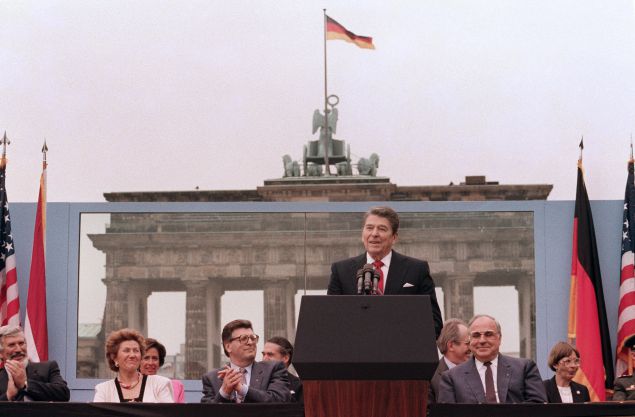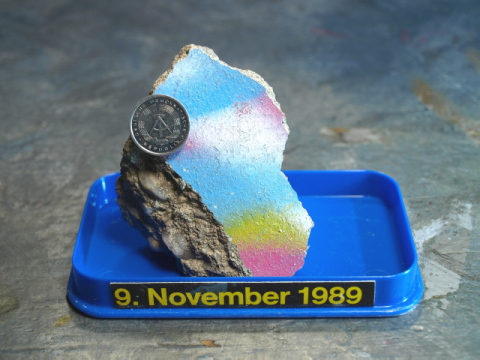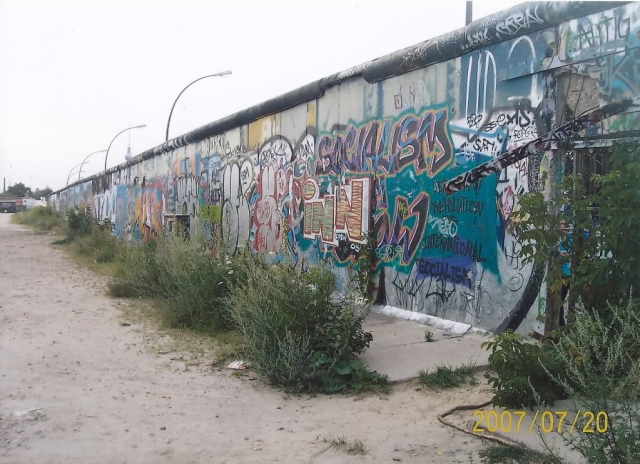Berlin Wall - "Tear Down This Wall!"

It was the challenge from U.S. President Ronald Reagan to Mikhail Gorbachev of Soviet Union. When President Reagan looked up at the space afar
and appealed to his counterpart to dismantle the Berlin Wall in a televised speech broadcast worldwide on 12 June 1987.
In that summer, after Reagan attended the G-7 summit in Venice, he made a short visit to Berlin to commemorate the 750th anniversary of Berlin.
In the visit, the Brandenburg Gate was chosen by Reagan to deliver an outdoor speech to the people of West Berlin just like President John Kennedy in 1963.
Photo: Getty Images, 1987
After the Second World War, Germany was partitioned into two: East Germany and West Germany.
The capital, Berlin, was trapped deep inside the east side and was also essentially divided into two cities.
The Soviet Union controlled East Berlin and the United States, Great Britain and France controlled West Berlin.
In 1961, the Berlin Wall was built to stop the outflow of people fleeing from the communist bloc to the west.
The wall surrounded West Berlin entirely except for a few checkpoints. The Brandenburg Gate stood on the west end of the
regal boulevard of Unter Den Linden inside East Germany but the plaza (Pariser Platz) behind the gate was well inside West Germany.
The gate was closed on 14 August 1961.
Many people attempted to get over the fortified wall and most failed. About 3,200 were arrested in the restricted zone,
120 were injured and over 160 were killed. The wall had become a symbol of the Cold War that divided Europe and the World -
a free democratic system and a rigid socialist system.
Before an attendance of 45,000, Reagan said in the speech:
"Behind me stands a wall that encircles the free sectors of this city, part of a vast system of barriers that divides the entire continent of Europe.
From the Baltic, south, those barriers cut across Germany in a gash of barbed wire, concrete, dog runs, and guard towers.
Farther south, there may be no visible, no obvious wall. But there remain armed guards and checkpoints all the same; still a restriction on the right to travel,
an instrument to impose upon ordinary men and women the will of a totalitarian state. Yet it is here in Berlin where the wall emerges most clearly;
here, cutting across your city, where the news photo and the television screen have imprinted this brutal division of a continent upon the mind of the world.
Standing before the Brandenburg Gate, every man is a German, separated from his fellow men. Every man is a Berliner, forced to look upon a scar.
...
We welcome change and openness; for we believe that freedom and security go together, that the advance of human liberty
can only strengthen the cause of world peace. There is one sign the Soviets can make that would be unmistakable,
that would advance dramatically the cause of freedom and peace.
General Secretary Gorbachev, if you seek peace, if you seek prosperity for the Soviet Union and Eastern Europe,
if you seek liberalization, come here to this gate.
Mr. Gorbachev, open this gate. Mr. Gorbachev, tear down this wall! "
Top|Bottom] of Page
His appeal was naturally dismissed by the Communist Bloc as a rhetoric provocation. Nevertheless, a chain of ensuing events might make one to re-consider
the weight of Reagan's speech.
Hungary opened the border to Austria on 23 August 1989 and to East Germany on 10 September 1989.
Thousands of East Germans seized upon this opportunity to escape to the West. Discontent grew and mass demonstrations suddenly happened in
East Germany from September to November. On 9 November 1989, the East German Government was pressured to lift the travel restrictions to the West.
In the evening, thousands of East Berliners came to border checkpoints. Initially, the border guards tried to check the travel documents but soon gave in and
allowed everyone to pass through completely unrestrained between the two sides of the city.
West Berliners gave the "visitors" an enthusiastic welcome and showered them with gifts. The two Berliners climbed to the top of the wall to greet
each other and celebrate. Fireworks lit the sky and cars continuously honked their horns on the boulevards in West Berlin.
That night and in the following days, throngs of people brought hammers and chisels to chip pieces out of the concrete wall for souvenirs.
Some used sledgehammers to knock down the wall. Soon, the East German Government removed the
barriers from all crossings in order to re-open the old roads. On 21 December 1989, construction workers used a crane
to remove the wall before Brandenburg Gate to open the gate for vehicle traffic.
Elsewhere, the Czech Parliament ended the communist rule in 30 November 1989 and a Romanian uprising overthrew communist rule in December 1989.
In October 1990, East and West Germany reunited. In 1991 the Warsaw Pact soon dissolved, and the Soviet Union finally broke up.


Left: Souvenir piece of the Wall with a 1988 DDR pfennig.
A large block of the wall is exhibited at the Ronald Reagan Presidential Library in California. (photo: Gordon Li)
Right: The concrete wall erected in 1976 was originally painted white or grey,
but the western sides were covered by colourful murals and graffiti. (source: photobucket.com)
Top|Middle] of Page